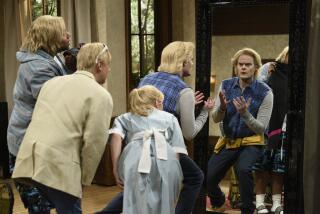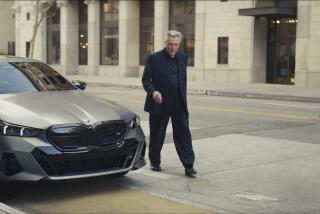Ads that soared, scored
- Share via
They are both subversives and establishmentarians, salesmen and entertainers, people who believe they are in the most exciting business on Earth. They are the giants of modern advertising, and they have some alluring tales to tell.
As recorded by Doug Pray in his dishy new documentary “Art & Copy,” the men and women who created the most memorable ads of our time, such as “Where’s the Beef?” and “Got Milk?,” tell rich, meaty war stories that prove the point made by the legendary Mary Wells, who says that people like her were “born with a gift for sensing what will turn you on.”
A veteran documentarian, with films such as “Hype!” and “Scratch” to his credit, Pray gamely tries to expand this film beyond talking heads. He shows us satellites being launched and periodically peppers the screen with factoids, for instance listing the number of billboards in America (450,000) and the cost of a 30-second TV spot on the Super Bowl ($2.7 million).
The truth is, however, he needn’t have bothered. It’s the great talkers of the advertising world whom we want to see and hear. They couldn’t be more different from each other, but they are all recognizable as members of the same irreverent, iconoclastic tribe, people who could make you walk a mile for a Camel and smile while you’re doing it.
Advertising hasn’t always attracted this kind of energy and enthusiasm. In the pre “Mad Men” days, the ad game was very much an old boys’ network: where you went to school mattered more than the kind of copy you wrote.
It was the inspiration of the 1960s firm Doyle Dane Bernbach for the first time to put a campaign’s art director and copywriter in the same room and unleash the kind of powerful creative force that led to such agency classics as the Volkswagen “Think Small” promotion and an American Tourister luggage spot that featured a gorilla attacking a suitcase.
Mary Wells was a Doyle Dane Bernbach alum, and she talks engagingly about how the “I (Heart) New York” campaign was born and what it took to convince staid Braniff International Airways to sign onto the “end of the plain plane” promo.
Dealing with reluctant clients who don’t have the faith in their product that the admen do is one of “Art & Copy’s” recurrent themes, but it’s never related with as much brio as when another New Yorker, George Lois, and his client, designer Tommy Hilfiger, disclose their history.
Hilfiger was close to a total unknown when Lois came up with a series of ads comparing him to the greats of American fashion. Hilfiger was mortified (“I didn’t want any part of this, I was truly embarrassed”) but the ads worked big time. “I have to drag them into being rich,” Lois grouses. “It makes me crazy.”
While the West Coast used to be the place where Madison Avenue-centric firms sent their discards, the new style in advertising made it a creative center. “Art & Copy” talks to Rich Silverstein and Jeff Goodby about the phenomenon that was their “Got Milk?” campaign, and to Lee Clow of TBWA/Worldwide about the 1984 Super Bowl ad that introduced Apple’s Macintosh.
One of the film’s most interesting stories comes from Dan Wieden of Portland, Ore.’s Wieden+Kennedy about the origins of their enormously successful “Just Do It” Nike ads. Turns out the inspiration was convicted killer Gary Gilmore, who said “Let’s do it” just before he was executed by a Utah firing squad in 1977.
Perhaps the most memorable West Coast voice is the golden-throated Hal Riney, who voiced most of his own commercials, including the “Morning in America” spots for the Ronald Reagan campaign that he talks about writing in a San Francisco bar. Riney also confesses that the human feeling he put into his campaigns was his way of compensating for the emotion that had been missing from his early life.
One of the main treats of “Art & Copy” is that it allows us to revisit those classic ads, all of which are just as exciting now as they were when they first ran. These advertising men and women just did it before it was a phrase, and their results speak for themselves.
--
--
‘Art & Copy’
MPAA rating: Unrated
Running time: 1 hour, 30 minutes
Playing: Laemmle’s Sunset 5, West Hollywood
More to Read
Only good movies
Get the Indie Focus newsletter, Mark Olsen's weekly guide to the world of cinema.
You may occasionally receive promotional content from the Los Angeles Times.







